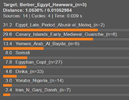The alchemist
VIP
I agree with this. I am talking about certain ancestors. When we see Greek and Italian-like ancestry with Levantine without any Caucasus and Iranian Neolithic enrichment in lower levels, people often jump to a generalized Roman catch-all. This cannot always be true. To me that can be a sign of non-Eastern Mediterranean (I mean Roman-type by this) ancestry. Often, Punic genetics was basically just Mediterranean with significant, still, minor North African and (even lesser) Levantine. I clearly mean what has been underemphasized rather than what is usually mentioned, not as a means to overcorrect but to weigh the scales in a cosmopolitan demographic historic view. The majority is clearly other mixtures mixture pulses, and perhaps, some earlier layers of Neolithic that might be overexpressed (as I did not include saples older than the Bronze Age), but I think there is a significant trace that is often lazily attributed to later movement.There’s multiple layers of Levantine ancestry depending on the origin of the individual especially if they are of urban origin. In general coastal tribal Berbers do have significant East Med ancestry from not just the Carthiginian (whose mercenaries many times were massively sourced from the East Med). Most of the Northern Berbers actually came much later to the Western Maghreb (Western Algeria/Northern Morocco Med coast)
My wife who is half Northern Berber/Arabized Berbers also has a substantial Levantine admix. You can see this East Med admix from Northern Moroccan Berbers all the way to Tunisian coastal Berbers. Libyans source majority of their Berber ancestry obviously from coastal Berbers that were absorbed by the Hilali/Sulaymi Bedouins as most Libyans lived along the coasts.
View attachment 374807
View attachment 374808
When you examine Punic-based maternal genetics in Algeria and Tunisia, one sees unquestionable pathways for descent that are more present than many people mention. This is not an ignorant, "oh, look Levantine, Phoenician"... In fact, it's that type of mentality I reject. I lowkey think it's because cadaans don't want to imagine there is any continuity between that civilization and extant North Africans. For example, how jubilant they became when individuals turned up like this:
(I did not try to be accurate. It's only a simple model to emphesize broad associations.)
The timing and the Mediterranean association, and the fact that Punic individuals turned up with those clades, are why I say that these are Punic-derived. One of them is literally the sample. These are not the only sub-clades that give an association.
By the way, either those Punic people are skewed from the Carthaginian cemetery or straight up, those guys had a significant genetic change by the time they hit Cyprus, prior to the Western Mediterranean landing. When you look at the Kerkouane cemetery DNA, it looks very mixed. What if, like these people, they never derived from full Levantines but mixed Aegean Philistine-type that settled in the Levant, became acculturated, but sort of re-expanded as a form of calling back to their roots or their seafaring, coupled with the economic prospects of exporting Levantine goods and adopting Levantine commercial and cultural lifeways? These might have been people from the Levant who had part Aegean roots.
If people say that the Philistine settled in the more southern region. That is correct, but why do we even assume they were the only ones? After all, the Philistines were one among many Aegean groups mentioned by the Ancient Egyptians. What I am saying is basically that Iron Age coastal Lebanon probably had a population segment with Aegean/Southern European influence, and it's partly in that ancestry that there is a re-expansion after acculturation and mixture with Phoenicians. I sort of don't buy the complete Phoenician going out if they have such little Levantine ancestry in northwest Africa. A rebuttal to this can be, "people mixed along the Aegean way" - but the temporal sets constraints, for we know it clearly that only about a century went by from when they expanded until they landed in northwest Africa.
Be rational for a second, as Aegean peoples appear, known to settle along the coast, suddenly a century or so later, coastal cities become urban commercial hubs, and from these do people shoot out to economically expand through expert seafaring, initially toward the same territories these Aegean people derived from? This is definitely an elephant in the room for me.

